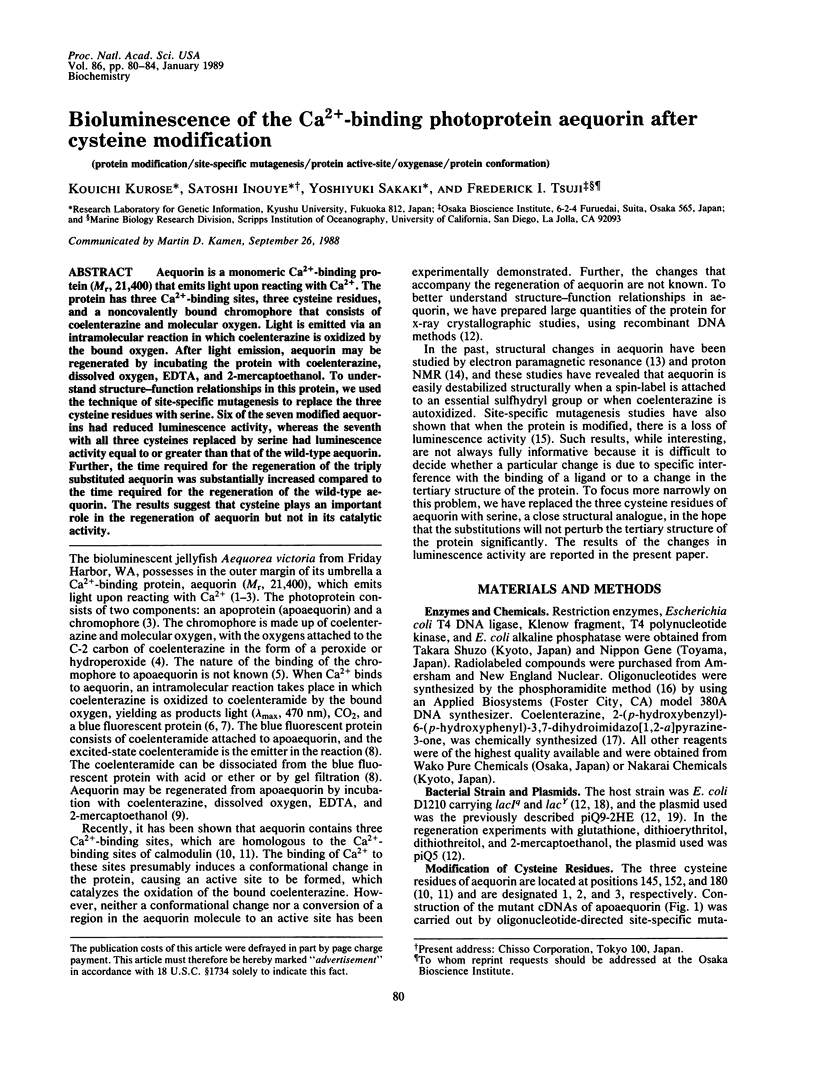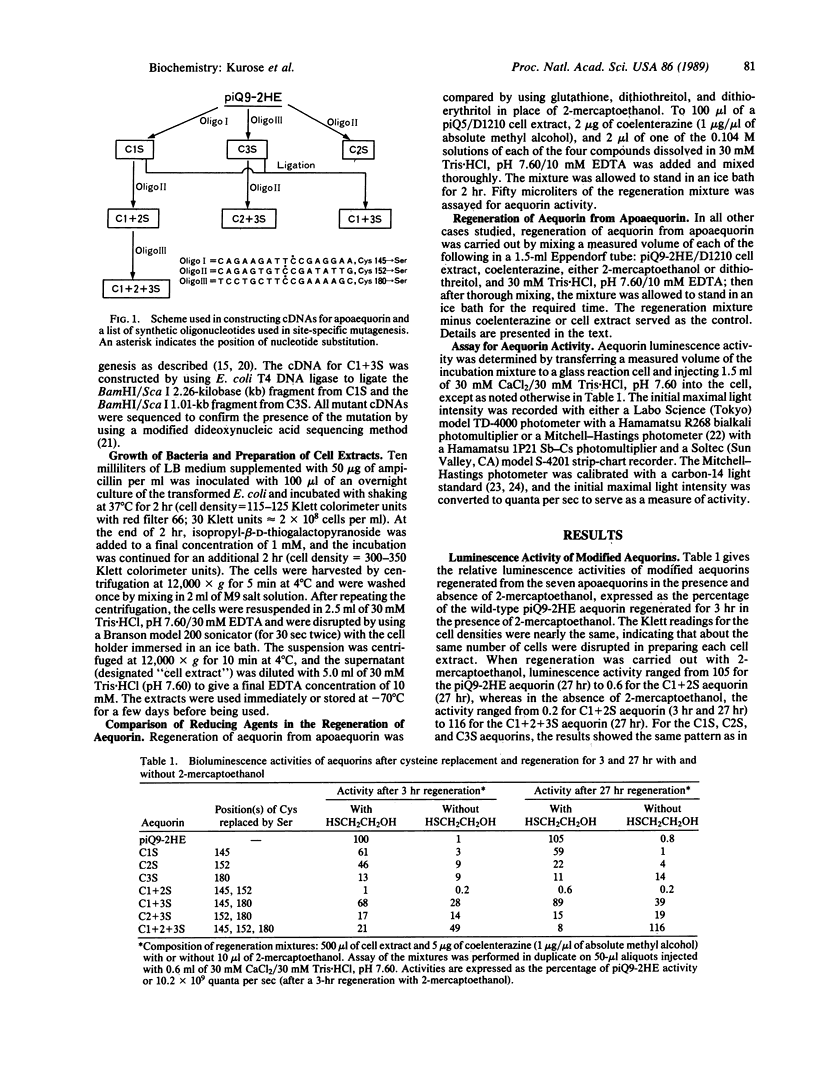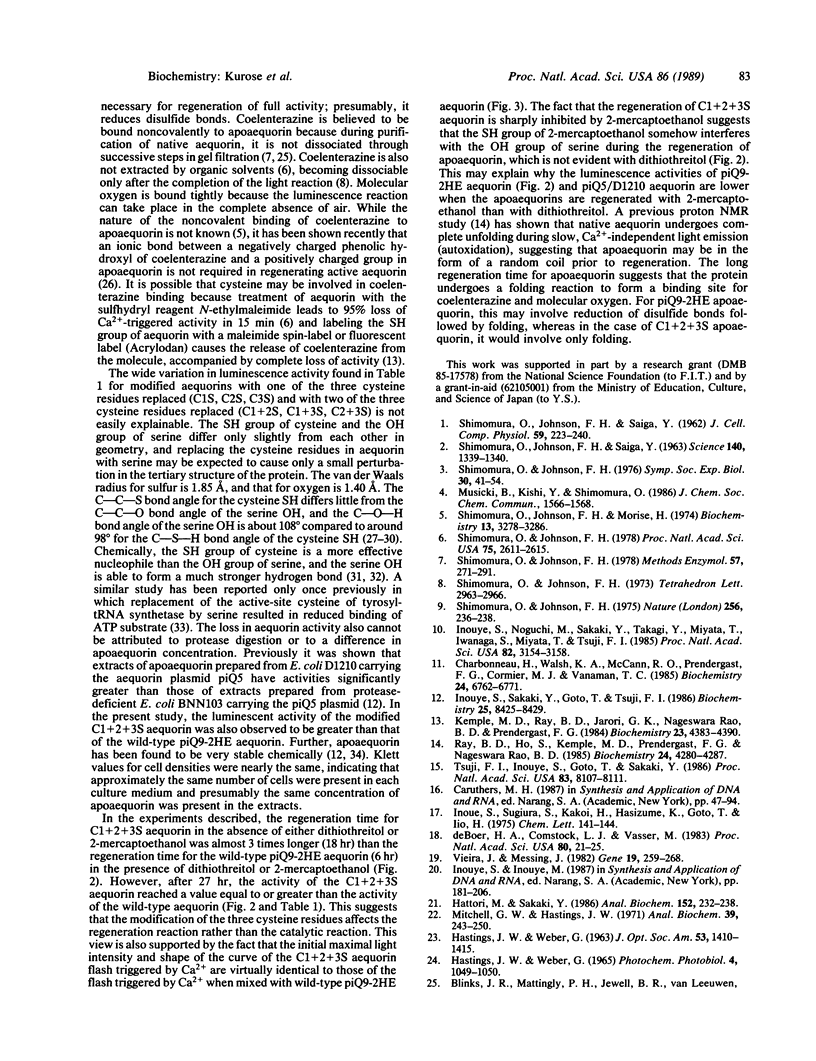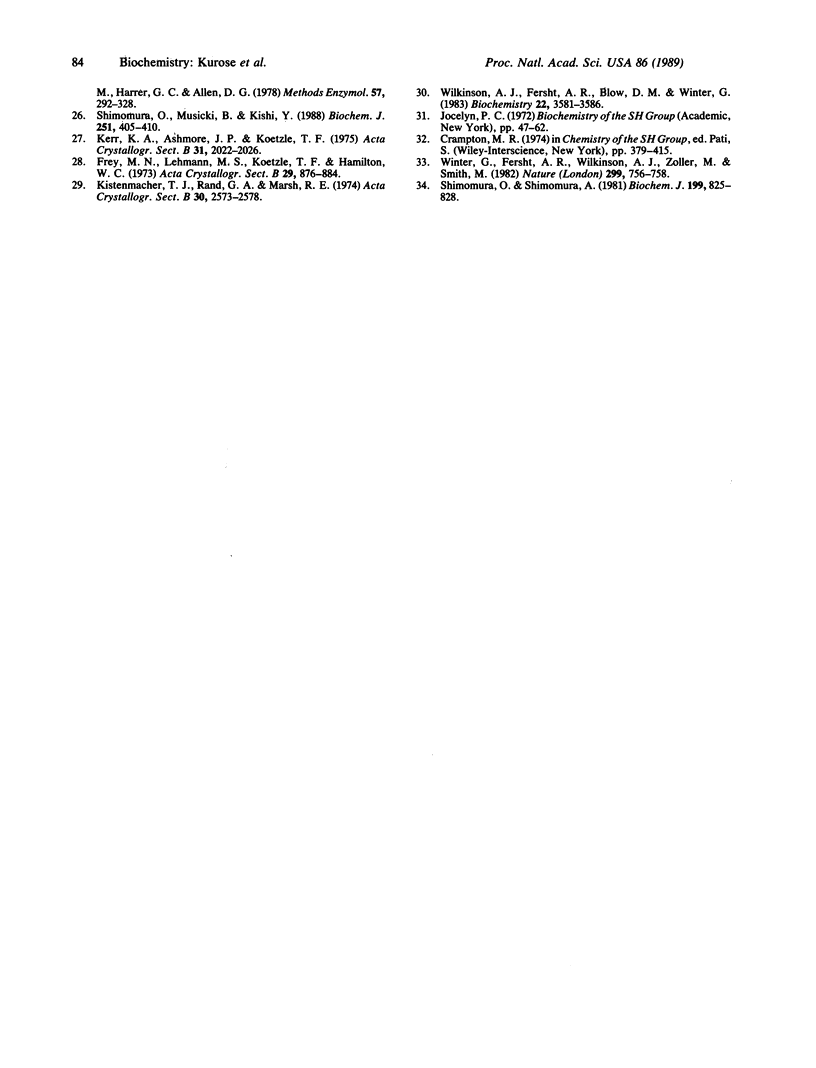Abstract
Aequorin is a monomeric Ca2+-binding protein (Mr, 21,400) that emits light upon reacting with Ca2+. The protein has three Ca2+-binding sites, three cysteine residues, and a noncovalently bound chromophore that consists of coelenterazine and molecular oxygen. Light is emitted via an intramolecular reaction in which coelenterazine is oxidized by the bound oxygen. After light emission, aequorin may be regenerated by incubating the protein with coelenterazine, dissolved oxygen, EDTA, and 2-mercaptoethanol. To understand structure-function relationships in this protein, we used the technique of site-specific mutagenesis to replace the three cysteine residues with serine. Six of the seven modified aequorins had reduced luminescence activity, whereas the seventh with all three cysteines replaced by serine had luminescence activity equal to or greater than that of the wild-type aequorin. Further, the time required for the regeneration of the triply substituted aequorin was substantially increased compared to the time required for the regeneration of the wild-type aequorin. The results suggest that cysteine plays an important role in the regeneration of aequorin but not in its catalytic activity.
Full text
PDF




Selected References
These references are in PubMed. This may not be the complete list of references from this article.
- Charbonneau H., Walsh K. A., McCann R. O., Prendergast F. G., Cormier M. J., Vanaman T. C. Amino acid sequence of the calcium-dependent photoprotein aequorin. Biochemistry. 1985 Nov 19;24(24):6762–6771. doi: 10.1021/bi00345a006. [DOI] [PubMed] [Google Scholar]
- Hattori M., Sakaki Y. Dideoxy sequencing method using denatured plasmid templates. Anal Biochem. 1986 Feb 1;152(2):232–238. doi: 10.1016/0003-2697(86)90403-3. [DOI] [PubMed] [Google Scholar]
- Inouye S., Noguchi M., Sakaki Y., Takagi Y., Miyata T., Iwanaga S., Miyata T., Tsuji F. I. Cloning and sequence analysis of cDNA for the luminescent protein aequorin. Proc Natl Acad Sci U S A. 1985 May;82(10):3154–3158. doi: 10.1073/pnas.82.10.3154. [DOI] [PMC free article] [PubMed] [Google Scholar]
- Kemple M. D., Ray B. D., Jarori G. K., Rao B. D., Prendergast F. G. Electron paramagnetic resonance of spin-labeled aequorin. Biochemistry. 1984 Sep 11;23(19):4383–4390. doi: 10.1021/bi00314a022. [DOI] [PubMed] [Google Scholar]
- Mitchell G. W., Hastings J. W. A stable, inexpensive, solid-state photomultiplier photometer. Anal Biochem. 1971 Jan;39(1):243–250. doi: 10.1016/0003-2697(71)90481-7. [DOI] [PubMed] [Google Scholar]
- Ray B. D., Ho S., Kemple M. D., Prendergast F. G., Nageswara Rao B. D. Proton NMR of aequorin. Structural changes concomitant with calcium-independent light emission. Biochemistry. 1985 Jul 30;24(16):4280–4287. doi: 10.1021/bi00337a005. [DOI] [PubMed] [Google Scholar]
- SHIMOMURA O., JOHNSON F. H., SAIGA Y. Extraction, purification and properties of aequorin, a bioluminescent protein from the luminous hydromedusan, Aequorea. J Cell Comp Physiol. 1962 Jun;59:223–239. doi: 10.1002/jcp.1030590302. [DOI] [PubMed] [Google Scholar]
- Shimomura O., Johnson F. H., Morise H. Mechanism of the luminescent intramolecular reaction of aequorin. Biochemistry. 1974 Jul 30;13(16):3278–3286. doi: 10.1021/bi00713a016. [DOI] [PubMed] [Google Scholar]
- Shimomura O., Johnson F. H. Peroxidized coelenterazine, the active group in the photoprotein aequorin. Proc Natl Acad Sci U S A. 1978 Jun;75(6):2611–2615. doi: 10.1073/pnas.75.6.2611. [DOI] [PMC free article] [PubMed] [Google Scholar]
- Shimomura O., Johnson F. H. Regeneration of the photoprotein aequorin. Nature. 1975 Jul 17;256(5514):236–238. doi: 10.1038/256236a0. [DOI] [PubMed] [Google Scholar]
- Shimomura O., Johnson F. H., Saiga Y. Microdetermination of Calcium by Aequorin Luminescence. Science. 1963 Jun 21;140(3573):1339–1340. doi: 10.1126/science.140.3573.1339. [DOI] [PubMed] [Google Scholar]
- Shimomura O., Musicki B., Kishi Y. Semi-synthetic aequorin. An improved tool for the measurement of calcium ion concentration. Biochem J. 1988 Apr 15;251(2):405–410. doi: 10.1042/bj2510405. [DOI] [PMC free article] [PubMed] [Google Scholar]
- Shimomura O., Shimomura A. Resistivity to denaturation of the apoprotein of aequorin and reconstitution of the luminescent photoprotein from the partially denatured apoprotein. Biochem J. 1981 Dec 1;199(3):825–828. doi: 10.1042/bj1990825. [DOI] [PMC free article] [PubMed] [Google Scholar]
- Tsuji F. I., Inouye S., Goto T., Sakaki Y. Site-specific mutagenesis of the calcium-binding photoprotein aequorin. Proc Natl Acad Sci U S A. 1986 Nov;83(21):8107–8111. doi: 10.1073/pnas.83.21.8107. [DOI] [PMC free article] [PubMed] [Google Scholar]
- Vieira J., Messing J. The pUC plasmids, an M13mp7-derived system for insertion mutagenesis and sequencing with synthetic universal primers. Gene. 1982 Oct;19(3):259–268. doi: 10.1016/0378-1119(82)90015-4. [DOI] [PubMed] [Google Scholar]
- Wilkinson A. J., Fersht A. R., Blow D. M., Winter G. Site-directed mutagenesis as a probe of enzyme structure and catalysis: tyrosyl-tRNA synthetase cysteine-35 to glycine-35 mutation. Biochemistry. 1983 Jul 19;22(15):3581–3586. doi: 10.1021/bi00284a007. [DOI] [PubMed] [Google Scholar]
- Winter G., Fersht A. R., Wilkinson A. J., Zoller M., Smith M. Redesigning enzyme structure by site-directed mutagenesis: tyrosyl tRNA synthetase and ATP binding. Nature. 1982 Oct 21;299(5885):756–758. doi: 10.1038/299756a0. [DOI] [PubMed] [Google Scholar]
- de Boer H. A., Comstock L. J., Vasser M. The tac promoter: a functional hybrid derived from the trp and lac promoters. Proc Natl Acad Sci U S A. 1983 Jan;80(1):21–25. doi: 10.1073/pnas.80.1.21. [DOI] [PMC free article] [PubMed] [Google Scholar]


